
94% of researchers rate our articles as excellent or good
Learn more about the work of our research integrity team to safeguard the quality of each article we publish.
Find out more
ORIGINAL RESEARCH article
Front. Mar. Sci., 18 January 2022
Sec. Physical Oceanography
Volume 8 - 2021 | https://doi.org/10.3389/fmars.2021.767850
This article is part of the Research TopicPhysics and Biogeochemistry of the East Asian Marginal SeasView all 30 articles
The southern Yellow Sea Cold Water Mass (YSCWM) and the Yellow Sea Warm Current (YSWC) are prominent features in the southern Yellow Sea. The traditional viewpoint is that the southern YSCWM exists in the warm half of the year and the YSWC exists in the cold half of the year; the most existing studies have regarded these features as independent ocean phenomenon. Through marine investigations conducted in the recent years in the southern Yellow Sea, the southern YSCWM was found to exist in the early winter in 2010, and the YSWC was observed in the early summer in 2013, 2014. For approximately half the year, the southern YSCWM and YSWC existed simultaneously, and the YSWC was located in a slightly high-temperature region in the middle of the southern YSCWM. A sandwich-shaped temperature structure formed in the middle of the southern Yellow Sea from spring to autumn. This article studies the seasonal variation characteristics of the three-dimensional southern YSCWM and YSWC structures using ocean survey data collected in the recent years. The new perspective of the seasonal variations in the southern YSCWM and YSWC obtained herein will promote the recognition of southern Yellow Sea water exchanges and support biogeochemical cycle research in the Yellow Sea.
The Yellow Sea is a semiclosed and shallow marginal sea located between the Chinese mainland and the Korean Peninsula. The Yellow Sea borders the Bohai Sea to the north and is open to the East China Sea to the south. A deep trough with a maximum depth of more than 80 m is located in the central Yellow Sea. The most important physical features of the Yellow Sea are the existence of the Yellow Sea Cold Water Mass (YSCWM) in the summer season and the Yellow Sea Warm
Current (YSWC) in the winter season. The YSCWM has important effects on the hydrographic features of the Yellow Sea as well as the local biogeochemical cycles and production (Huo et al., 2012; Ni et al., 2013). The stratification of the YSCWM significantly regulates biogeochemical processes, while nutrients accumulate in the bottom-layer waters from spring to autumn, making the YSCWM area an important nutrient pool (Wei et al., 2020). At its peak, the YSCWM normally occupies one-third of the bottom layers of the Yellow Sea in summer (Su and Weng, 1994), and the YSCWM is a more conservative water mass than the other water masses that have been identified in the Yellow Sea. The YSWC is the only current that transports high-salinity water from the East China Sea into the Yellow Sea and is located around the western side of the central deep trough.
Based on historical hydrographic observations, He et al. (1959) suggested that the northern YSCWM forms locally during winter due to surface cooling and strong vertical mixing. Guan (1963) found that the temperature of the northern YSCWM in summer is closely related to the local air temperature recorded in the previous winter and that the waters in the YSCWM are nearly motionless with little change in temperature during summer (Li and Yuan, 1992). Guan (1963) also indicated that the summertime temperature of the bottom-layer waters of the northern YSCWM has a great relationship with the local air temperature in winter. Regarding the seasonal variation in the southern YSCWM, the water mass appears in spring, develops in summer, and decays in fall (Zhang et al., 2008). The southern YSCWM is the strongest in summer and has two cold cores; one cold core is formed locally southeast of the Shandong Peninsula, and the other is located west of the western Korean coast (Yu et al., 2006; Zhang et al., 2008).
The YSWC was first identified by Uda (1935) based on the hydrographic data and drift-bottle trajectories. The main characteristic of the YSWC is that it transports warm, saline water from the Tsushima Warm Current to the Yellow Sea. However, Nitani (1972) and Guan (1994) also suggested that the YSWC might flow northward along the trough in the central Yellow Sea. Guan and Mao (1982) further indicated that the YSWC extends into the northern Yellow Sea and even into the inner part of the Bohai Sea. Early current observations found that the YSWC is transient and emerges during the relaxation stages of the cold storms (Hsueh, 1988; Hsueh and Yuan, 1997; Lie et al., 2001, 2009). Yu et al. (2010) first observed the persistent existence of the YSWC along the western flank of the central trough of the Yellow Sea in winter. The current was strongest near the bottom layer. An analysis of potential vorticity balances by Lin et al. (2011) indicated that the YSWC undergoes a westward shift due to the potential vorticity input by wind stress over the Yellow Sea trough, but is also strongly influenced by bottom friction. Regarding the seasonal variation in the YSWC, it is generally believed to be the strongest in winter and weak in spring but to not extend into the Yellow Sea in summer (Park, 1986). For example, Tang and Zou (2001) suggested that the YSWC exists only from November through April.
Generally, the common perception of the YSCWM and YSWC is that the YSCWM exists in the warm half of the year and the YSWC exists in the cold half of the year; few studies have focused on the relationship between the YSCWM and YSWC. However, we identified the existence of the YSCWM in December 2009 by a field survey in the southern Yellow Sea and the existence of the YSWC by a bottom-mounted mooring current meter in early July 2014. These observation results contradict the results of the previous studies, so it is necessary to explore the annual variations in the YSCWM and YSWC using these new observations. These observation results also explain the formation of 2 cold cores in the middle of the southern YSCWM.
From 2006 to 2015, more than 20 shipboard survey cruises were conducted by the research group of the author in the southern Yellow Sea to investigate the hydrographic seasonal variation characteristics of the YSCWM and YSWC. The first early winter identification of the southern YSCWM occurred during the cruise in December 2009, and by the subsequent cruise in January 2010, the YSCWM had disappeared. The earliest springtime appearance of the southern YSCWM was identified during the cruise in April 2007. Therefore, the data from the above 3 cruises were used to investigate the seasonal evolution patterns of the southern YSCWM and YSWC. The temperature and salinity profile data were collected by Seabird 911 conductivity, temperature, and depth (CTD) instruments with temperature and conductivity accuracies of ± 0.001°C and ± 0.0003 S/m, respectively. The sample rate was 24 Hz, and the vertical resolution of the final data following the quality-control and filtering processes was 1 m. The spatial interval of the stations was 30 km in longitude. The temperature and salinity section data were plotted using Ocean Data View software (Schlitzer, 2021).
Approximately, 40 bottom-mounted mooring systems were also integrated with the Seabird Hydrocat CTD instruments and an RDI 300-kHz acoustic Doppler current profiler (ADCP) was deployed during each cruise. The sample intervals of the ADCP and CTD instruments were 30 min and the vertical resolution of the ADCP was 2 m. The cosine-Lanczos filter (Emery and Thomson, 2001) was used to remove tidal signals with periods of 8 days. The residual flow was analyzed to reflect the current conditions in the southern Yellow Sea.
Many studies have indicated that the 35°N section can best represent the YSCWM and YSWC in the southern Yellow Sea (Yu et al., 2006; Zhang et al., 2008). In this article, we used CTD data collected at 35°N during the 3 cruises in December 2009, January 2010, and April 2007 to study the seasonal structures of the YSCWM and YSWC in the southern Yellow Sea. The bottom temperature and the current data recorded by the 4 bottom-mounted moorings along the YSWC path were used to investigate the evolution of the YSWC. The positions, deployment times, and recovery times of these moorings are listed in Table 1.
The YSCWM was identified within the 35°N section in early December of 2009 (Figure 1), but the survey results obtained in the mid-January of 2010 showed that the YSCWM no longer existed (Figure 2). Although the thermocline descended to a depth of approximately 50 m, the 2 cold cores of the YSCWM were clearly located at similar positions to those identified in summer, when the YSCWM is the strongest within the year. These observations were not consistent with the traditional understanding that the YSCWM forms in spring, strengthens in summer, and weakens or disappears in autumn. From the observations obtained in the Yellow Sea from 2009 to 2010, the lifetime of the YSCWM can be speculated to extend to early winter. The relatively high temperature measured at approximately 123°E between the 2 cold cores in the YSCWM implied the appearance of the YSWC in the same time period.
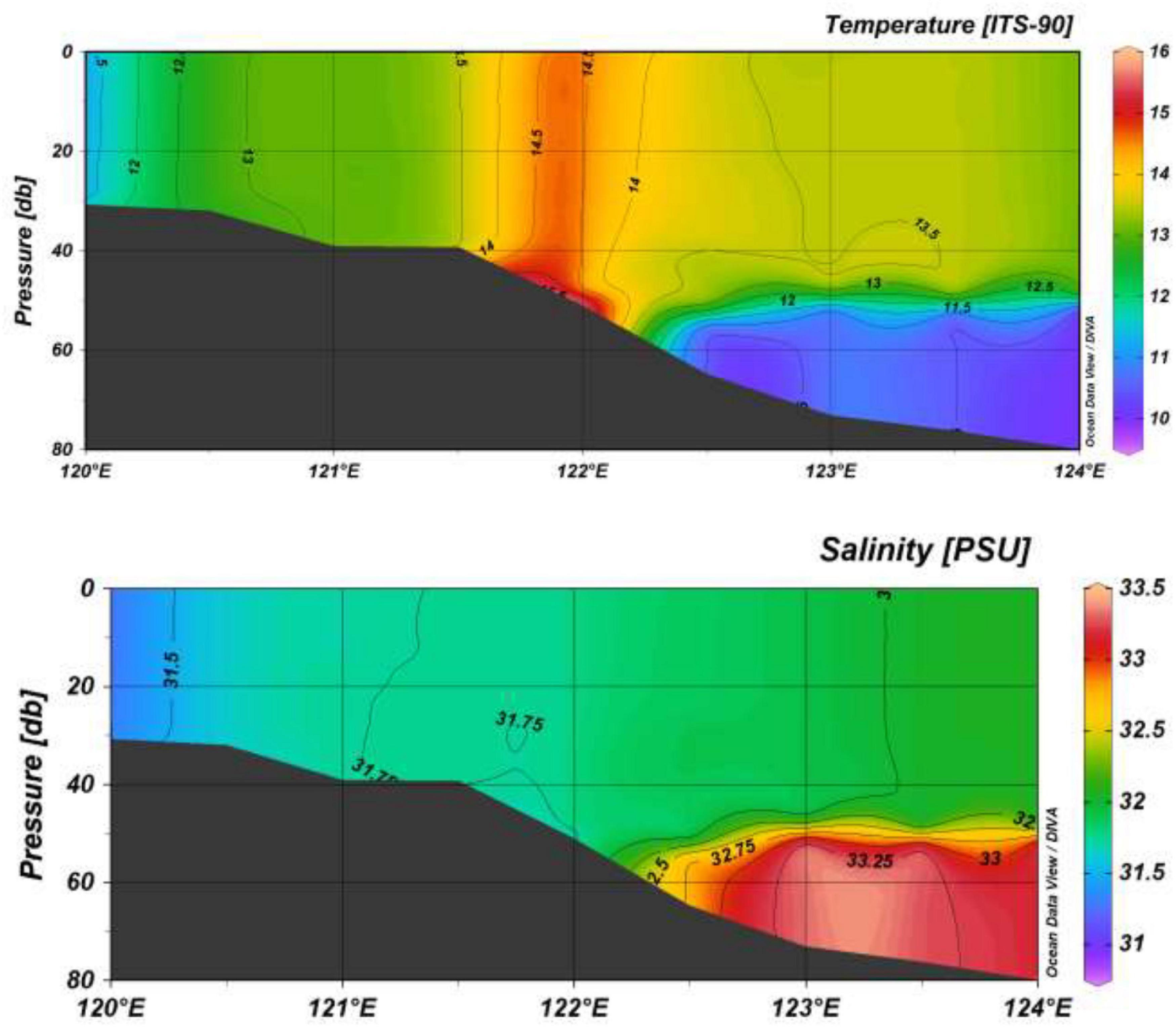
Figure 1. Temperature and salinity distributions in the 35°N section of the southern Yellow Sea in December 2009 (the section was measured between December 6 and December 8, 2009).
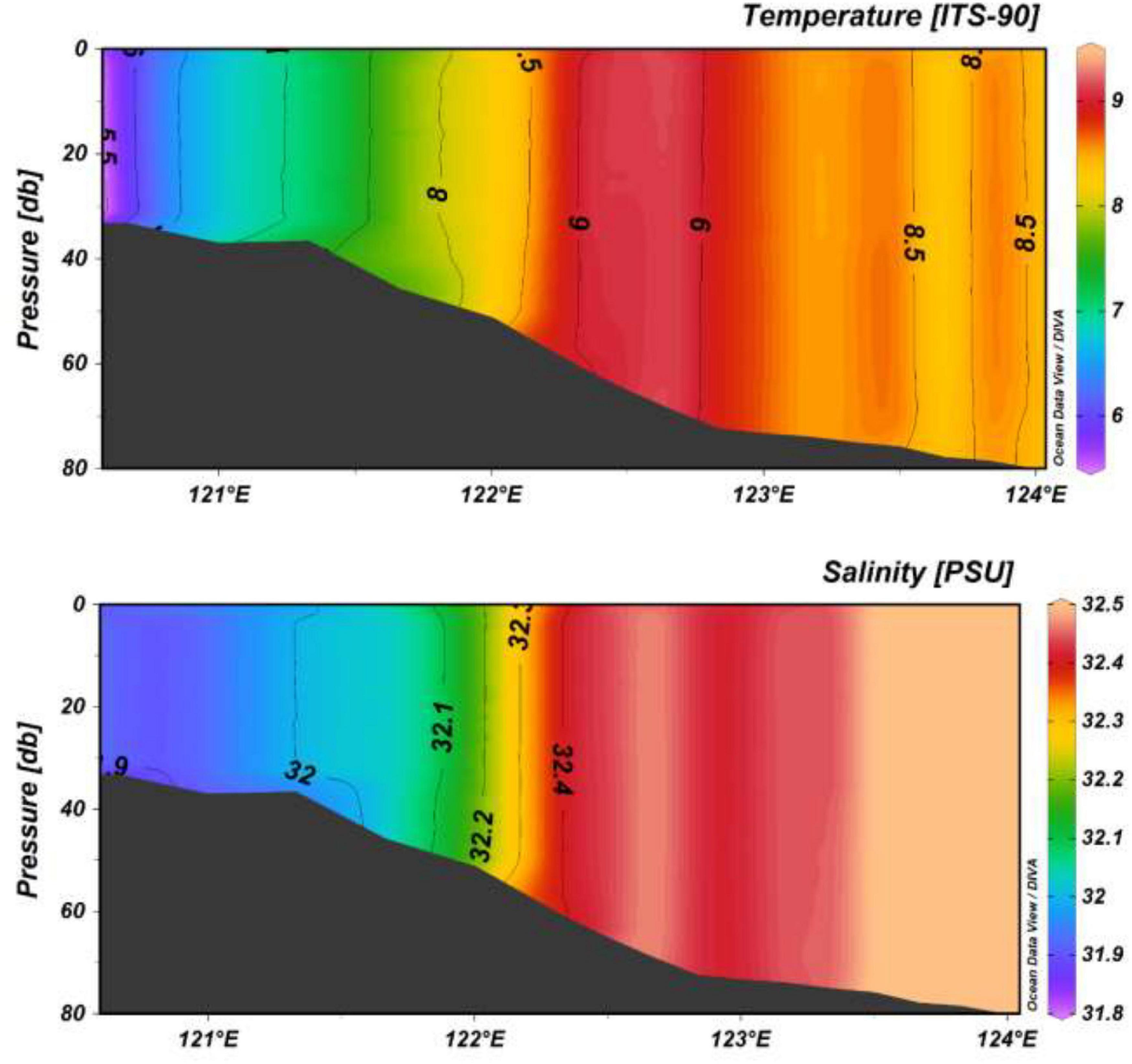
Figure 2. Temperature and salinity distributions in the 35°N section of the southern Yellow Sea in January 2009 (the section was measured between January 28 and January 29, 2010).
Regarding the early appearance of the southern YSCWM in spring, the field survey conducted in April of 2007 (Figure 3) showed that the western cold core of the southern YSCWM began to form in April. Because the easternmost point was located at 124°E, only a small signal of the eastern cold core could be identified in the southern YSCWM. Some studies have also regarded the 2 cold cores of the southern YSCWM as the Qingdao offshore cold water mass (QDCWM) and Incheon offshore cold water mass. Between these 2 cold cores, relatively high-temperature and high-salinity water masses exist, indicating the existence of the YSWC. Zou et al. (2000, 2001) indicated that the middle-layer cold water mass had the same life period and location as the QDCWM. Surface warming and the existence of the YSWC near the bottom layer together induce the middle-layer cold water mass. However, the middle-layer cold water mass suggests the springtime existence of the YSWC. Zhang et al. (1996, 2002, 2004) showed that the QDCWM appeared in March, stabilized in April, strengthened in May, weakened in June, and disappeared in July. This work further illustrates that the southern YSCWM may appear as early as March.
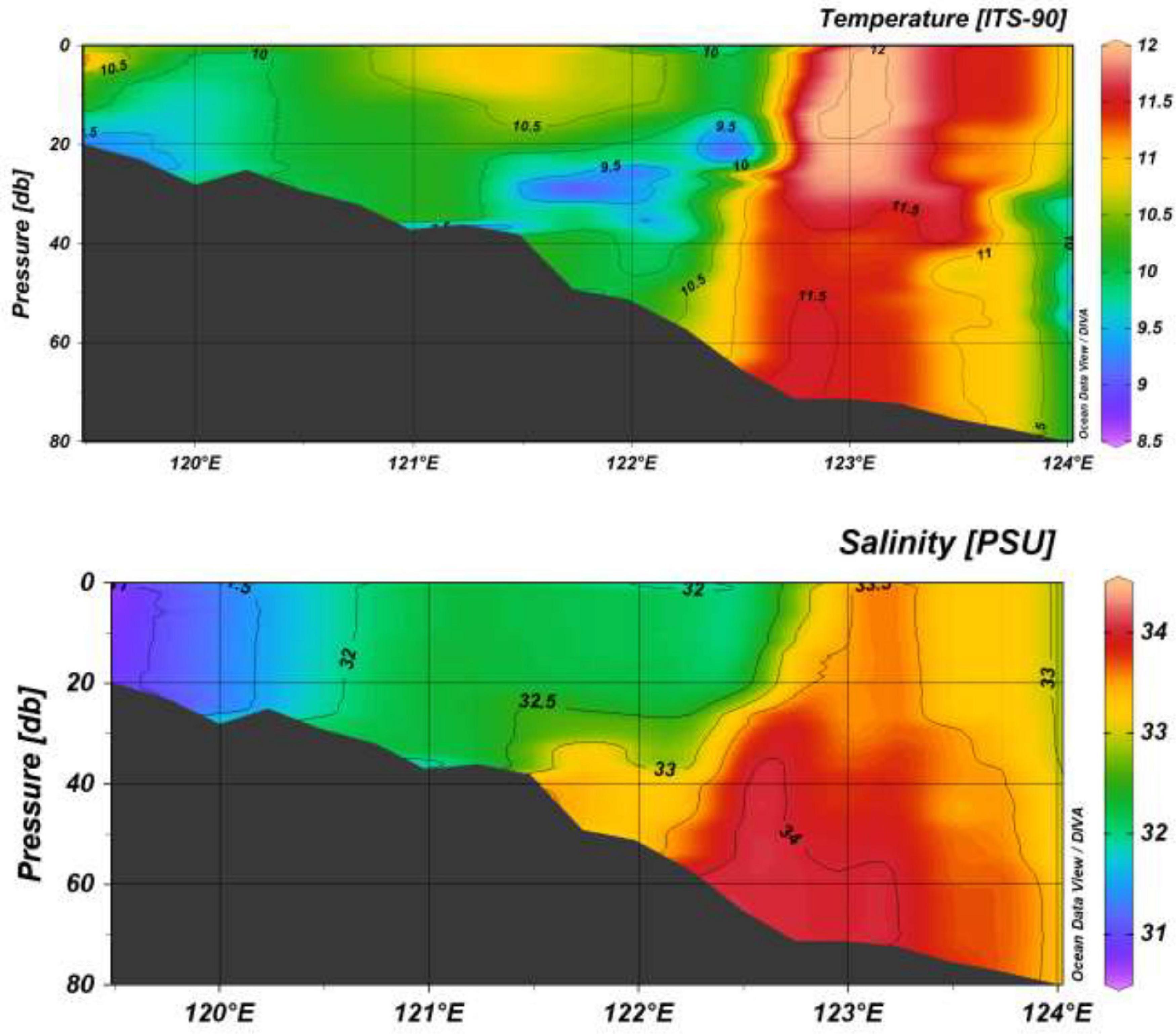
Figure 3. Temperature and salinity distributions in the 35°N section of the southern Yellow Sea in January 2007 (the section was measured between April 13 and April 15, 2007).
From the hydrographic analysis, the relatively warm cores identified in spring and early winter suggest that the YSWC may exist in these seasons, although direct current measurements are needed to prove the existence of the YSWC. The long-term monitoring of water properties and currents in the Yellow Sea is challenging because of the heavy fishing activities that occur in the area. Yu et al. (2010) first observed the existence of the YSWC in winter using 1-month current data obtained from a bottom-mounted ADCP. Two bottom-mounted moorings with CTD and ADCP instruments were deployed in the relatively warm core area during the spring–summer periods of 2013 and 2014 to observe the YSWC. The de-tide-filtered mooring data collected in 2013 indicate clear increasing trends in both the near-bottom temperature and salinity measurements from spring to mid-summer with periodic (∼2 weeks) oscillations, with both the variables reaching their maxima in late June (Figure 4A). Since then, both temperature and salinity decreased consistently throughout the rest of the deployment period. The 2014 mooring (Figure 4B) began collected data in June, and therefore, also showed a similar increasing trend from June to early August for both temperature and salinity. The temperature and salinity measurements subsequently decreased from early August through mid-October. In both deployment periods, the temperature variations were small, between 8.8 and 9.8°C in 2013 and between 9.2 and 9.9°C in 2014. The salinity variations in 2013 were also small, between 32.5 and 32.75. However, the salinity variations in 2014 were much more significant, between 32.8 and 33.4. The increasing trends in salinity and temperature from spring to summer indicated that the lifetime of the YSWC may extend into early summer, and the differences between the data collected in 2013 and 2014 suggest the existence of interannual variations in the YSWC in the southern Yellow Sea.
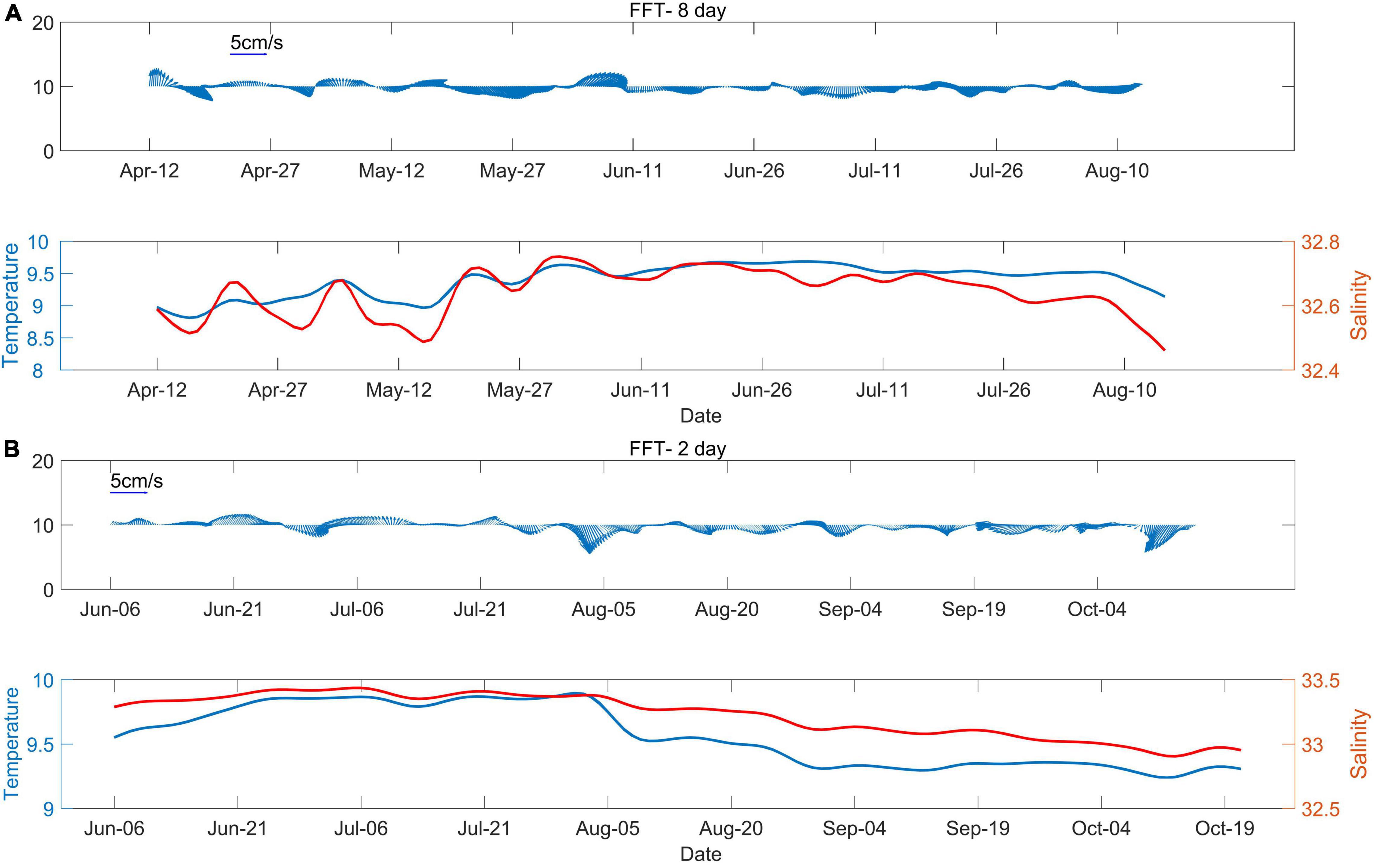
Figure 4. The bottom current, temperature and salinity time series from April 11, 2013 to August 16, 2013 (A) and the bottom current, temperature and salinity time series from June 5, 2014 to October 23, 2014 (B).
Overall, the variations in the bottom temperature and salinity conditions were clearly correlated with the bottom currents, particularly the N–S component (Figure 4A). For example, the bottom currents were generally oriented northward between mid-April and mid-June in 2013, corresponding to the increased temperature and salinity conditions recorded during the same period. After mid-June in 2013, the bottom currents turned largely southward, and the temperature and salinity measurements continuously decreased throughout the rest of the deployment. The 2014 current data showed similar correspondences between the bottom temperature, salinity, and current measurements as those identified in 2013. In particular, the southward current turn started over a month later in 2014 than in 2013, at the turn of July and August. At approximately the same time, both the temperature and salinity measurements started to decrease following their peak values, and these decreases continued throughout the rest of the deployment. Notably, the currents observed during both deployments were generally weak, with rates < 5 cm/s, with significant periodic oscillations, contrasting with the much stronger YSWC current that occurs in winter and may reach 15 cm/s (Yu et al., 2010). The current direction change occurs half a month earlier than the changes in the temperature and salinity trends.
The mooring observations provide evidence that the YSWC can continue into summer. The initialization time of the YSWC was analyzed using the observations recorded by the mooring deployed from October to November 2007 (Figure 5). The monthly mean current data indicate the appearance of a northward current from the sea bottom to 15 m above the sea bottom. The monthly average speed of this current was approximately 2–3 cm/s, which is slower than that measured in winter.
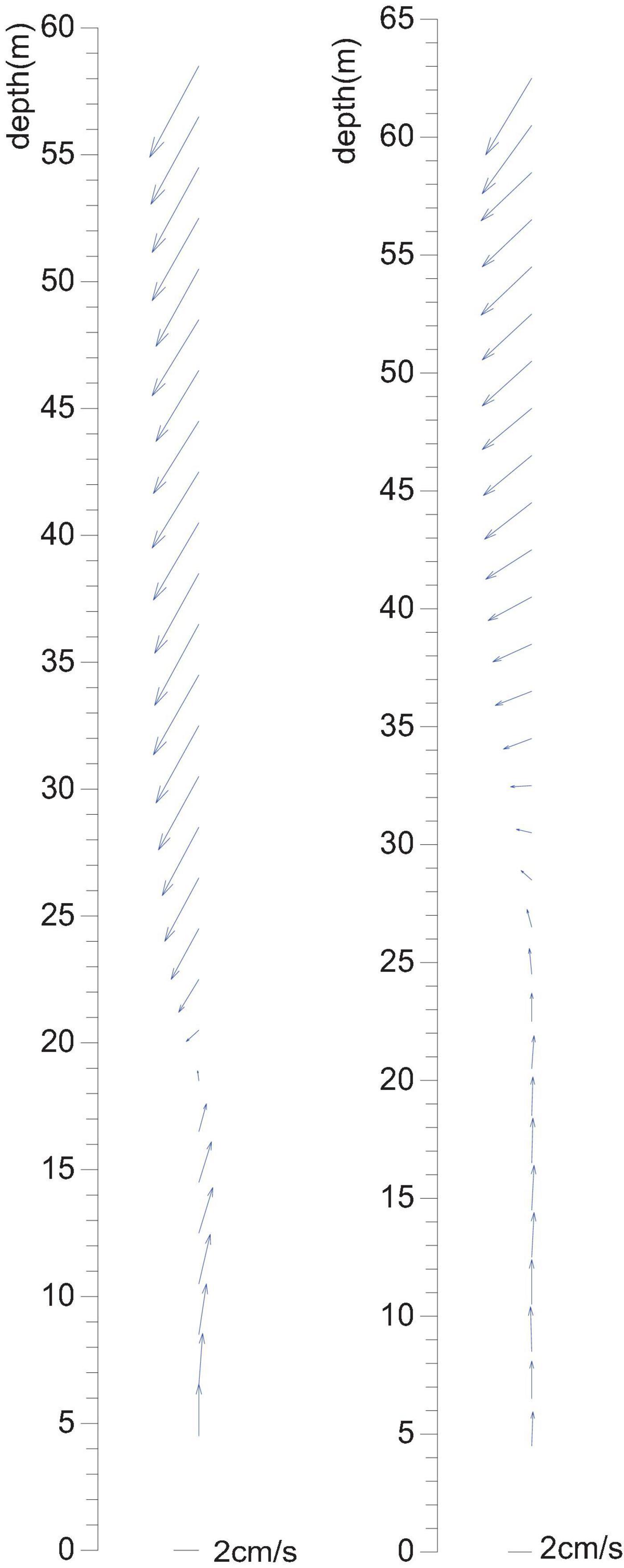
Figure 5. The monthly mean current profiles of M4-2007AUT (left) and M5-2007AUT (right) (depth 0 m indicating bottom).
Based on hydrographic and the current data collected from shipboard surveys and bottom-mounted moorings, the seasonal evolution patterns of the southern YSCWM and YSWC were analyzed in this study. The results reveal seasonal evolution patterns of the southern YSCWM and YSWC that are incongruent with the traditional viewpoints. The southern YSCWM appears in spring, strengthens in summer, and is maintained into autumn or even early winter. The YSWC appears in autumn, strengthens in winter, and can still exist in early summer. Therefore, the southern YSCWM and YSWC exist concurrently in the southern Yellow Sea during spring and autumn.
From the temperature and salinity section distribution measured at 35°N in spring and autumn (Figures 1–3), the southern YSCWM always has 2 cold cores with a relatively warm water mass between them. These results indicate the existence of the YSWC in these seasons, and the current observations confirm that the water mass is from the YSWC. Even in summer, when the mooring data show that there is no YSWC, relatively warm water still exists in the area. Because the speed of the southward bottom current in August is only 2 cm/s (Figure 4), the amount of cold water transported from the north Yellow Sea is small and cannot destroy the relatively warm water structure located between the 2 cold cores. The intrusion of the YSWC introduces warm and saline waters, thus, splitting the southern YSCWM into the two parts to form a sandwich-like structure. Many studies have found that the southern YSCWM has 2 cold cores (Yu et al., 2006; Zhang et al., 2008), but to date, no researchers have recognized the relatively warm water as the YSWC. From this work, the lifetimes of both the southern YSCWM and YSWC were found to reach up to 10 months each year. Approximately half of the year, the southern YSCWM and YSWC existed simultaneously in spring and autumn, when the YSWC was located in the middle of the southern YSCWM with a slightly high temperature and high salinity. Figure 6 summarizes the new recognition of the southern YSCWM and YSWC in spring and autumn. The YSWC is located near the sea bottom between the 2 cold cores of the southern YSCWM. These 2 cold cores and the YSWC water mass together form the YSCWM in the southern Yellow Sea in spring and autumn.
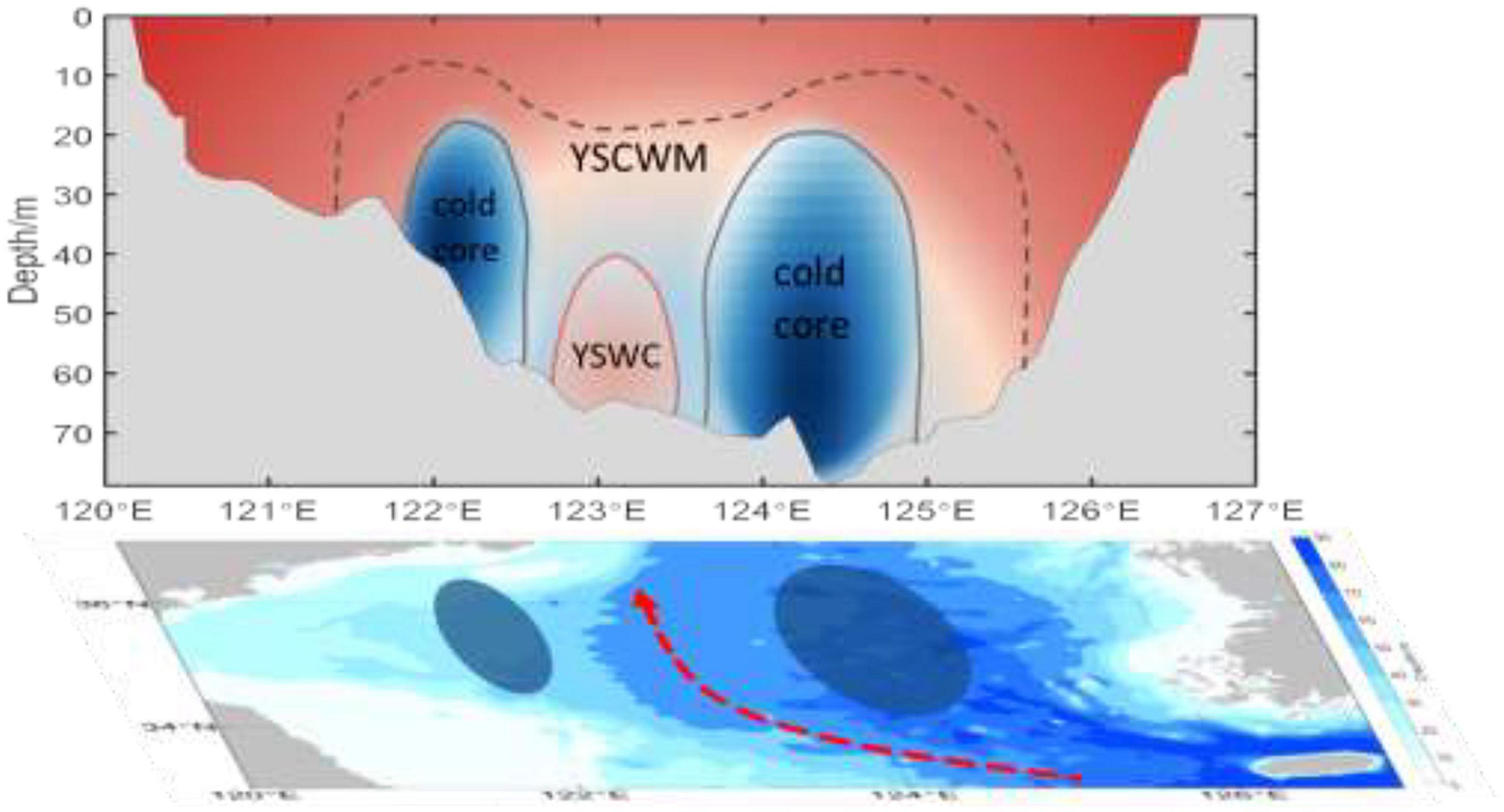
Figure 6. Schematic structure of the YSCWM and YSWC in spring and autumn (the upper panel shows the section structures of the YSCWM and the lower panel shows the corresponding bottom distributions).
The YSCWM and YSWC are the most important dynamic phenomena in the Yellow Sea, and the corresponding dynamic processes are fundamental for biogeochemical cycles and fishery variations. Thus, almost all the research that has been conducted on biogeochemical cycles in the southern Yellow Sea has regarded the dynamic processes of the YSCWM and YSWC under traditional viewpoints. Therefore, the new recognition of the southern YSCWM and YSWC will promote multidisciplinary research in the Yellow Sea, especially, in the spring and autumn seasons. Because the field survey data and mooring observations were not collected in the same time period, distinct interannual variations exist in the main current and water mass data; these variations are important for dynamic regional and ecological-environmental variations. These phenomena will be studied in the future by accumulating data and new progress in the numerical modeling.
The raw data supporting the conclusions of this article will be made available by the authors, without undue reservation.
All authors listed have made a substantial, direct, and intellectual contribution to the work, and approved it for publication.
This study was supported by the National Key Research and Development Plan (No. 2017YFC1403401) and the National Natural Science Foundation of China (No. 41676005).
The authors declare that the research was conducted in the absence of any commercial or financial relationships that could be construed as a potential conflict of interest.
All claims expressed in this article are solely those of the authors and do not necessarily represent those of their affiliated organizations, or those of the publisher, the editors and the reviewers. Any product that may be evaluated in this article, or claim that may be made by its manufacturer, is not guaranteed or endorsed by the publisher.
We would thank all the personnel of R/V Science No. 3 for their contribution to the data acquisition.
Emery, W. J., and Thomson, R. E. (2001). Data Analysis Methods in Physical Oceanography. Amsterdam: Elsevier Science.
Guan, B., and Mao, H. (1982). A note on circulation of the East China Sea. Chin. J. Oceanol. Limnol. 1, 5–16. doi: 10.1016/j.vetmic.2010.04.005
Guan, B.-X. (1994). “Patterns and structures of the currents in Bohai, Huanghai and East China Seas,” in Oceanology of China Seas, eds D. Zhou et al. (Dordrecht: Kluwer Academic Publishers), 17–26. doi: 10.1007/978-94-011-0862-1_3
Guan, P.-H. (1963). A Preliminary study of the temperature variations and the characteristics of the circulation of the cold water mass of the yellow sea. Oceanol. Limnol. Sin. 4, 255–284.
He, C.-P., Wang, Y. X., Lie, Z. Y., and Xu, S. (1959). A prelimenary study of the formation of yellow sea cold mass and its properties. Oceanol. Limnol. Sin 1, 1–15. doi: 10.1007/s13131-013-0346-9
Hsueh, Y. (1988). Recent current observations in the eastern Yellow Sea. J. Geophys. Res. Oceans 93, 6875–6884. doi: 10.1016/j.jconhyd.2020.103730
Hsueh, Y., and Yuan, D. (1997). A numerical study of currents, heat advection, and sea-level fluctuations in the Yellow Sea in winter 1986. J. Phys. Oceanogr. 27, 2313–2326.
Huo, Y., Sun, S., Zhang, F., Wang, M. X., Li, C. L., and Yang, B. (2012). Biomass and estimated production properties of size-fractionated zooplankton in the Yellow Sea, China. J. Mar. Syst. 94, 1–8. doi: 10.1016/j.jmarsys.2011.09.013
Li, H., and Yuan, Y. (1992). On the formation and maintenance mechanisms of the cold water mass of the Yellow Sea. Chin. J. Oceanol. Limnol. 10, 97–106.
Lie, H. J., Cho, C. H., Lee, J. H., Lee, S., Tang, Y. X., Zou, E. M., et al. (2001). Does the Yellow Sea Warm Current really exist as a persistent mean flow?” J. Geophys. Res. Oceans 106, 22199–22210. doi: 10.1029/2000JC000629
Lie, H. J., Cho, C.-H., and Lee, S. (2009). Tongue-shaped frontal structure and warm water intrusion in the southern Yellow Sea in winter. J. Geophys. Res. Oceans 114:C01003. doi: 10.1029/2007JC004683
Lin, X., Yang, J. Y., Guo, J. S., Zhang, Z. X., Yin, Y. Q., Song, X. Z., et al. (2011). An asymmetric upwind flow, Yellow Sea warm current: 1. New observations in the western Yellow Sea. J. Geophys. Res. Oceans 116:C04026. doi: 10.1029/2010JC006513
Ni, S., Du, J., Liu, S., and Zhang, J. (2013). Nutrient fluxes via radium isotopes from the coast to offshore and from the seafloor to upper waters after the 2009 spring bloom in the Yellow Sea. Deep Sea Res. Part II 97, 33–42. doi: 10.1016/j.dsr2.2013.05.003
Nitani, H. (1972). “Beginning of the Kuroshio,” in Kuroshio, Physical Aspect of the Japan Current, eds H. Stommel and K. Yoshida (Seattle, WA: University of Washington Press). doi: 10.1007/978-3-319-00822-6_2
Park, Y.-H. (1986). Water characteristics and movements of the Yellow Sea Warm Current in summer. Prog. Oceanogr. 17, 243–254. doi: 10.1016/0079-6611(86)90047-9
Schlitzer, R. (2021). Ocean Data View. Available online at: https://odv.awi.de
Su, Y. S., and Weng, X. C. (1994). “Water masses in China seas,” in Oceanology of China Seas, eds D. Zhou, Y. Liang, C. Zeng, and C. K. Tseng (Dordrecht: Kluwer Academic Publishers), 3–16. doi: 10.1007/978-94-011-0862-1_2
Tang, Y., and Zou, E. (2001). “Some feature of circulation in the Southern Huanghai Sea,” Proceedings of the 2001 11th PAMS/JECSS Workshop, Cheju.
Uda, M. (1935). The results of simultaneous oceanographical investigations in the North Pacific Ocean adjacent to Japan made in August, 1933. J. Imperial Fish. Exp. Stn. 6, 1–130.
Wei, Q., Wang, B., Yao, Q., Yu, Z., Fu, M., Sun, J., et al. (2020). Spatiotemporal variability of physical-biogeochemical processes and intrinsic correlations in the semi-enclosed South Yellow Sea. Acta Oceanol. Sin. 39, 11–26. doi: 10.1007/s13131-020-1656-3
Yu, F., Zhang, Z., Diao, X., and Guo, J. (2010). Observational evidence of the Yellow Sea warm current. Chin. J. Oceanol. Limnol. 28, 677–683. doi: 10.1007/s00343-010-0006-2
Yu, F., Zhang, Z. X., Diao, X. Y., Guo, J. S., and Tang, Y. X. (2006). Analysis of evolution of the Huanghai Sea Cold Water Mass and its relationship with adjacent water masses. Acta Oceanol. Sin. 28, 26–34.
Zhang, Q., Hou, Y., Cheng, M. H., Liu, X. Q., Yin, B. S., and Wang, X. Y. (2004). Variation features in Qingdao cold water mass strength. Stud. Mar. Sin. 46, 13–21. (in Chinese with English abstract).
Zhang, Q., Liu, X., Cheng, M., and Yu, X. (2002). Characteristics and formation causes of Qingdao cold water mass. Chin. J. Oceanol. Limnol. 20, 303–308. doi: 10.1007/BF02847919
Zhang, Q., Weng, X., and Yang, Y. L. (1996). Analysis of water masses in the south Yellow Sea in spring. Oceanol. Limnol. Sin. 27, 421–428. (in Chinese with English abstract).
Zhang, S. W., Wang, Q., Lü, Y., Cui, H., and Yuan, Y. (2008). Observation of the seasonal evolution of the Yellow Sea Cold Water Mass in 1996–1998. Cont. Shelf Res. 28, 442–457. doi: 10.1016/j.csr.2007.10.002
Zou, E. M., Guo, B. H., Tang, Y. X., and Lee, H. (2000). The hydrographic features and water masses analyses of the southern Huanghai Sea in the spring of 1996. Acta Oceanol. Sin. 22, 17–26. (in Chinese with English abstract).
Keywords: southern Yellow Sea Cold Water Mass, Yellow Sea Warm Current (YSWC), seasonal variation, coexistence, sandwich structure
Citation: Fei Y, Qiang R, Xinyuan D, Chuanjie W and Yibo H (2022) The Sandwich Structure of the Southern Yellow Sea Cold Water Mass and Yellow Sea Warm Current. Front. Mar. Sci. 8:767850. doi: 10.3389/fmars.2021.767850
Received: 31 August 2021; Accepted: 12 November 2021;
Published: 18 January 2022.
Edited by:
SungHyun Nam, Seoul National University, South KoreaReviewed by:
Jun Sun, China University of Geosciences, ChinaCopyright © 2022 Fei, Qiang, Xinyuan, Chuanjie and Yibo. This is an open-access article distributed under the terms of the Creative Commons Attribution License (CC BY). The use, distribution or reproduction in other forums is permitted, provided the original author(s) and the copyright owner(s) are credited and that the original publication in this journal is cited, in accordance with accepted academic practice. No use, distribution or reproduction is permitted which does not comply with these terms.
*Correspondence: Yu Fei, eXVmQHFkaW8uYWMuY24=
Disclaimer: All claims expressed in this article are solely those of the authors and do not necessarily represent those of their affiliated organizations, or those of the publisher, the editors and the reviewers. Any product that may be evaluated in this article or claim that may be made by its manufacturer is not guaranteed or endorsed by the publisher.
Research integrity at Frontiers

Learn more about the work of our research integrity team to safeguard the quality of each article we publish.